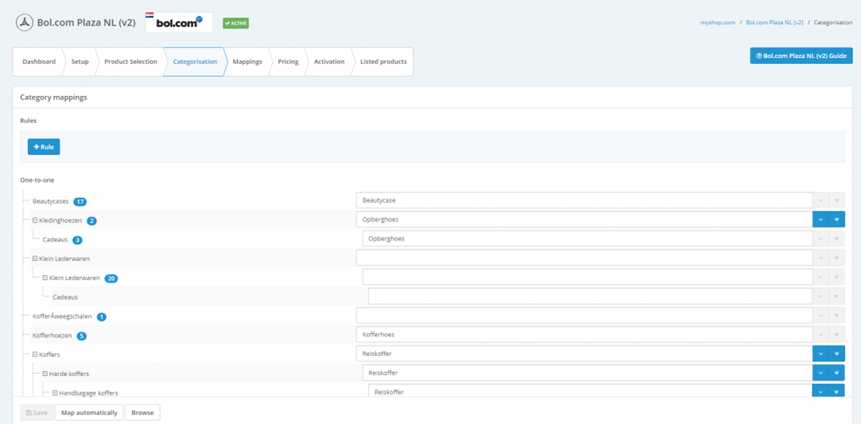Product categorization and product taxonomy are essential components of any successful ecommerce strategy. Product categorization refers to the process of organizing products into hierarchical structures, enabling shoppers to find what they need quickly and efficiently. It is a large scale classification task that assigns a category path to a particular product. Typically, product categorization has a tree structure with 3 or more levels of depth and a few leaf nodes.
Product taxonomy, on the other hand, is the overarching structure that dictates how these categories are arranged, ensuring coherence and logical flow from broad to specific product details. By employing an effective ecommerce product taxonomy, you can create a seamless user experience that enhances product discoverability and supports downstream processes such as search, filtering, and recommendations.
An organized product taxonomy not only aids in categorization but also improves site navigation, supports backend processes, and provides a framework that scales with growing product catalogs. It acts as the backbone for maintaining consistency, facilitating better data management, and enabling intuitive browsing for customers.
Ecommerce sites use hierarchical taxonomies to organize products from generic to specific classes where each level provides more specific details about the product than the previous level. In particular, the upper level of categorization is relatively coarse and manually predefined. It is based on the product type and not the detailed sub-sub-category you might see on the marketplace.
The categories of the lower level are more concrete and fine-grained. They are defined by more descriptive and specific details about the product. For instance, "women's shoes" is a more detailed category than "shoes," which gives a more precise understanding of the product.

What is Product Taxonomy?
Product taxonomy is a structured framework that organizes products in a layered hierarchy, moving from broad to specific attributes to ensure easy navigation and discovery. This taxonomy starts with generic categories and branches into more detailed levels, encompassing product types, subcategories, and specifications.
For instance, in an electronics store, the taxonomy might start with "Electronics" as a top-level category, narrow to "Mobile Phones," and further specify "Smartphones" or "Basic Phones." While product taxonomy defines this organizational framework, categorization is the act of placing products within the structure. Together, taxonomy and categorization streamline product discovery and enhance the shopping experience.
Benefits of effective product categorization
Unlike traditional physical stores where you can walk around and look for assistance, online stores rely on their product catalog (product categorization). And a well-executed ecommerce product categorization system offers numerous advantages that extend beyond simple product placement. Here are some key benefits:
- Enhanced user experience:
A structured product taxonomy simplifies navigation, helping users locate items effortlessly and explore related products. This ease of use contributes to higher customer satisfaction and repeat purchases. - Operational efficiency:
By establishing clear product categories, ecommerce platforms can streamline inventory management, order processing, and overall workflow. - SEO and marketing alignment:
Thoughtful product categorization best practices ensure that product pages are optimized for search engines, enhancing online visibility and attracting more organic traffic. - Personalized recommendations:
Accurate categorization allows platforms to leverage data for personalized product recommendations, increasing cross-sell and upsell opportunities.
Overall, ecommerce product taxonomy plays a pivotal role in the effective organization of ecommerce operations, providing a foundation for strategic growth and enhanced customer engagement.
Product categorization best practices
Effective product categorization relies on clear naming conventions, alignment with business objectives, and a focus on customer search behavior.
- Names should be intuitive and concise, directly conveying product categories to users.
- Organizing categories according to your target audience’s expectations improves usability while adjusting them over time based on browsing and purchasing behavior keeps them relevant.
- Regularly analyze customer interactions, such as search queries and conversion rates, to identify potential gaps or improvements in the categorization. This helps ensure that the product structure aligns with user needs and drives better discovery and sales.
- Maintain a consistent visual layout and logical category hierarchy throughout the site. This creates an intuitive navigation experience, helping customers locate products quickly and fostering trust in the overall shopping experience.
Tools like ours aid in this process, providing efficient methods for creating and adjusting product categories to match user demand. A continuous feedback loop helps maintain an organized, customer-centric catalog that supports both usability and sales.
AI in Product Categorization: Automation and Innovation
AI technology is transforming product categorization, especially in managing extensive catalogs. Automation reduces manual efforts by suggesting and even creating categories based on product attributes, making the process faster and more accurate.
AI-driven category mapping, such as the Smart Mapping feature in our Seller Hub, matches products to relevant categories automatically, enhancing discoverability.
This automation helps retailers save time and avoid errors while ensuring products appear in the right categories for customers. AI also brings innovation to categorization by learning from user behavior and trends, enabling a more dynamic, responsive categorization approach.

What are the 4 challenges of product categorization?
Smart and detailed product categorization offers several benefits to both the ecommerce platform and its buyers. However, creating, maintaining, or adapting a current categorization standard is a very demanding process. The correct path depends on customers' search behavior, available departments, and their intricate organization.
To understand the peculiarities that are unique to this process, let's take a look at the possible situations:
- Product categorization might sound rather simple: choose the right department for a product. In practice, this process is complicated by the sheer volume of products on many ecommerce platforms. Also, there might be quite some products that belong to multiple categories. For instance, the item "Women volleyball shirt" could use 2 different paths, starting in "Clothing, Shoes & Accessories" or "Sporting Goods."
- Sometimes, when you 'translate' your categories to the specific marketplace categories, you have a 1-on-1 match. Unfortunately, more often than not, the level of detail doesn't match. In essence, either your category is too specific compared to the marketplace product type, or the category tree is in a completely different language. To fix this, your ecommerce product categorization should be aligned with the marketplace’s taxonomy by mapping categories effectively and using flexible templates.
- Due to the wide variety of products sold on ecommerce channels, it is quite challenging to define all available product attributes (including their unique set of attributes). Automation tools and AI-driven product taxonomy solutions can help scale this process, reducing manual workload and increasing accuracy.
- Catalogs have a dynamic nature where old products get retired, and new products are added daily. To address this, employ adaptive technologies that can update and reorganize the product taxonomy dynamically, ensuring consistency over time.
ChannelEngine provides solutions that address these challenges by offering advanced automation and seamless integration capabilities, making product categorization more efficient and effective.
How to perform product categorization?

Every ecommerce channel has a specific product categorization. If a seller is on multiple channels, it means that he has to perform categorizations numerous times. Automation of this process allows to reduce costs and provide better catalog quality.
ChannelEngine offers a smooth, customer-friendly set-up to deal with product categorization and mapping. Here, you are just a few steps away from hassle-free automated results. In the image below, you can see merchant categories with a number of products for each of them (on the left). On the right, you see empty bars. Here you have to link your categories to the categories of the channel. You can 'Browse' to get an overview of all categories of the marketplace. Also, you have an option to select 'Map automatically.' It allows you to check all your categories for a matching category based on the name.

Sometimes you might face a situation when your category is not specific enough; however, you have to split it up. ChannelEngine allows you to do it by creating a rule. It is possible to apply it based on one or more attributes, so all complying products are included. For example, you can split "bags" into "shoulder bags" and "backpacks."
Future trends in product categorization and taxonomy
Emerging trends like voice and visual search, AI-powered categorization, and personalized shopping experiences are shaping the future of product taxonomy and categorization. As these technologies advance, taxonomies must evolve to include keywords and image-based descriptors that align with new shopping behaviors.
The usage of AI in ecommerce will become progressively more vital in comprehending buyer intent, enabling tailored category suggestions based on personal preferences. By adjusting to these changes, companies can satisfy the needs of tech-savvy consumers and establish a taxonomy framework that facilitates future expansion and smooth shopping experiences.
Product categorization and ecommerce product taxonomy are integral to building an efficient and user-friendly online platform. An adaptable and well-structured system supports seamless navigation, operational efficiency, and enhanced customer experiences.
Embracing automation and AI solutions can further refine the categorization process, saving time and resources while maintaining high catalog quality. ChannelEngine offers a comprehensive solution for tackling these challenges, enabling businesses to optimize their categorization efforts and ensure long-term success. Explore these options to enhance your ecommerce platform and remain competitive in an ever-changing market.




